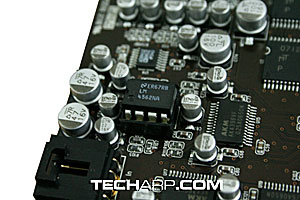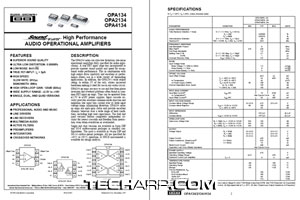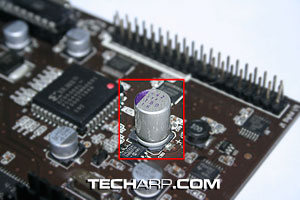The LM4562NA Operational Amplifier
The first thing that catches my eye was the LM4562 operational amplifier (opamp) in its socket. Auzentech certainly chose better than I expected.
This is a relatively new but extremely respected opamp in the audiophile community. It is known for its extremely high power supply ripple rejection ratio (PSRR). This is the ability to make sure fluctuations in the power supply do not get into the output.
It also has an equally high common-mode rejection ratio (CMRR). This refers to its ability to make sure that signals common to both inputs, mostly noise, are rejected.
The LM4562 also has an incredibly low total harmonic distortion (THD), extremely low noise and very good open loop gain. It's a hard opamp to tame as it has a tendency to oscillate, but I guess the Auzentech engineers got it right. Hell, I've been using these opamps for 6 months in my DAC and amps before I got this sound card and I have been nothing but impressed by their musicality and accuracy when it comes to music reproduction.
The OPA2134 Operational Amplifier
The basic “non-jellybean” chip that everyone starts out with. It is inherently stable, great-sounding, not very picky with supply and gain and surely not as expensive as the OPA2107 or the OPA637.
I've been through tons of amps that utilize this dinky little opamp and for the price, it's pretty good. It sure isn't an opamp from the likes of the NE5533 and gang, but neither is it high-end like the OPA2107, the LM4562 or the AD774. It does its job well enough though.
Since only the center and rear channels are passing through these opamps, I believe Auzentech's choice here is a prudent one. Plus, I love the Burr Brown house sound which is known for its butter smooth and hard hittingly deep bass.
Solid Capacitors
Solid capacitors (also known as Organic Aluminum Electrolyte capacitors) have major advantages over their liquid-based cousins. First of all, they don't have a tendency to blow or bloat up. They also have extremely low Equivalent Series Resistance (ESR). This makes them electrically superior to their liquid-based cousins.
Solid capacitors also have better ripple values. This mean they can take on higher levels of fluctuating current. In addition, they have comparable dissipation factor levels.
I can't tell what brand of capacitors Auzentech used in the X-Fi Prelude 7.1, but the purple one within the power supply section is the Sanyo OSCON SVP. That is one of the best and most expensive capacitors you can get (barring Sanyo's own SEPC series). Auzentech engineers made a good choice here. This level of capacitor quality is relatively unseen outside high-end circles. As such, I welcome it very much!







 Add to Reddit
Add to Reddit



